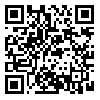Volume 3, Issue 2 (June 2024)
IJER 2024, 3(2): 121-132 |
Back to browse issues page
Download citation:
BibTeX | RIS | EndNote | Medlars | ProCite | Reference Manager | RefWorks
Send citation to:



BibTeX | RIS | EndNote | Medlars | ProCite | Reference Manager | RefWorks
Send citation to:
Jahangiri S, Sharifzadeh M, Hassanvand M. (2024). Studying the Functional Role of Social Cultural Dimensions of Contemporary Art from the Perspective of Sociology of Art. IJER. 3(2), 121-132. doi:10.22034/3.2.121
URL: http://ijer.hormozgan.ac.ir/article-1-160-en.html
URL: http://ijer.hormozgan.ac.ir/article-1-160-en.html
1- PhD student, Department of History, Central Tehran Branch, Islamic Azad University, Tehran, Iran
2- Professor of Art Department, Central Tehran Branch, Islamic Azad University, Tehran, Iran ,moh.sharifzade@iauctb.ac.ir
3- Associate Professor, Department of Painting, Faculty of Art and Architecture, University of Tarbiat Modares, Tehran, Iran
2- Professor of Art Department, Central Tehran Branch, Islamic Azad University, Tehran, Iran ,
3- Associate Professor, Department of Painting, Faculty of Art and Architecture, University of Tarbiat Modares, Tehran, Iran
Abstract: (918 Views)
Objective: In the 20th century, the changes that occurred in the field of art along with the advancement of technology and technology provided the ground for the presence of contemporary art. Today's art world requires a different expression. Contemporary art was formed in contemporary society with regard to new concepts and without relying on common traditions. The field of culture, art and industry is constantly influencing each other and the change and evolution of each one has a direct effect on the other. In this research, the relationship between art, culture and how contemporary art works is examined from the perspective of the theory of formation and reflection to answer the question of what is the effect of contemporary art on cultural formation and the effect and action of these two categories on each other?
Methods: The research method is based on descriptive-analytical nature and the method of collecting information is library.
Results: The results show that contemporary art can have the aspect of creating culture and awareness in the society and at the same time express the problems of the society and existing social concerns.
Conclusions: Therefore, it can be posited that, based on the attributes of this form of art and the presence of a reciprocal interaction with society, it serves as a reflection of societal norms and holds sway over both the viewers and the development of cultural norms. Indeed, this art form originates from the core of society and exerts an impact on its inhabitants.
Methods: The research method is based on descriptive-analytical nature and the method of collecting information is library.
Results: The results show that contemporary art can have the aspect of creating culture and awareness in the society and at the same time express the problems of the society and existing social concerns.
Conclusions: Therefore, it can be posited that, based on the attributes of this form of art and the presence of a reciprocal interaction with society, it serves as a reflection of societal norms and holds sway over both the viewers and the development of cultural norms. Indeed, this art form originates from the core of society and exerts an impact on its inhabitants.
Type of Study: Original |
Subject:
Educational Studies
Received: 2023/08/9 | Accepted: 2024/02/10 | Published: 2024/06/1
Received: 2023/08/9 | Accepted: 2024/02/10 | Published: 2024/06/1
References
1. Alexander, V. D. (2020). Sociology of the arts: Exploring fine and popular forms. John Wiley & Sons.
2. Benjamin, W. (2008). The work of art in the age of its technological reproducibility, and other writings on media. Harvard University Press. [DOI:10.2307/j.ctv1nzfgns]
3. Dadvar, A., & Mafitabar, A. (2018). A Comparative Study of Reflection Approach in Figurative Paintings of Nader Shah and Napoleon. Glory of Art (Jelve-y Honar) Alzahra Scientific Quarterly Journal, 10(2), 27-44. [DOI:10.22051/jjh.2018.238.]
4. Farshid Nik, F. (2022). The Social Responsibility of the Artist and the Critical Function of Art in the Face of Natural Disasters The Case of Art Programs in the Aftermath of Hurricane Katrina in the United State. Sociology of Art and Literature, 13(2), 79-105. [DOI:10.22059/jsal.2021.333177.666094]
5. Gharedaghi, I., Rezaei, A., Ghayoumi, A., Salehi Amiri, S. R., & Soltanifar, M. (2022). Cultural Products Advertising and Presentation of A Suitable Model for the Promotion of Cultural Products. Journal of Culture-Communication Studies, 23(59), 219-247. [DOI:10.22083/jccs.2021.303199.3435]
6. Haeri, V., & Rostami, M. R. (2011). Cultural advertising from theory to practice. Tabalvor Publication.
7. Inglehart, R., & Baker, W. E. (2000). Modernization, cultural change, and the persistence of traditional values. American sociological review, 65(1), 19-51. [DOI:10.1177/000312240006500103]
8. Leavy, P. (2020). Method meets art: Arts-based research practice. Guilford publications.
9. Lucie-Smith, E. (2005). Concepts and Approaches in the Last Artistic Movements of the Twentieth Century: Globalization and Modern Art. Tehran: Nazar Publishing House.
10. Marcus, G. E., & Myers, F. R. (1995). The traffic in culture: refiguring art and anthropology. Univ of California Press. [DOI:10.1525/9780520354920]
11. O'sullivan, J., & Heinonen, A. (2008). Old values, new media: Journalism role perceptions in a changing world. Journalism Practice, 2(3), 357-371. [DOI:10.1080/17512780802281081]
12. Ramin, A. (2008). Basics of Sociology of Art. Nei Publication.
13. Russo, F., Mannarini, T., & Salvatore, S. (2020). From the manifestations of culture to the underlying sensemaking process. The contribution of semiotic cultural psychology theory to the interpretation of socio‐political scenario. Journal for the Theory of Social Behaviour, 50(3), 301-320. [DOI:10.1111/jtsb.12235]
14. Terkashund, N. (2010). Art work And Reflective Approach In sociology Of Art. Journal of Fine Arts: Visual Arts, 1(40), 25-32. [DOI:10.22059/jfava.2009.68301]
15. Thomasson, A. L. (2005). The ontology of art and knowledge in aesthetics. The journal of aesthetics and art criticism, 63(3), 221-229. [DOI:10.1111/j.0021-8529.2005.00202.x]
16. Varnum, M. E., Grossmann, I., Kitayama, S., & Nisbett, R. E. (2010). The origin of cultural differences in cognition: The social orientation hypothesis. Current directions in psychological science, 19(1), 9-13. [DOI:10.1177/0963721409359301]
Send email to the article author
| Rights and permissions | |
 |
This work is licensed under the Creative Commons - Attribution 4.0 International. |







